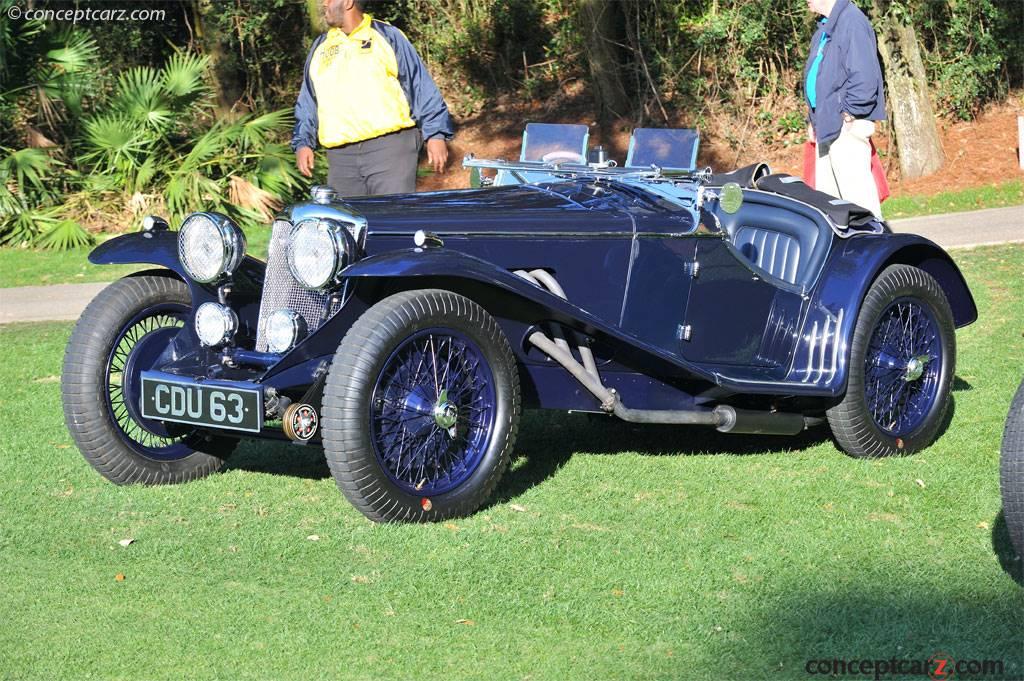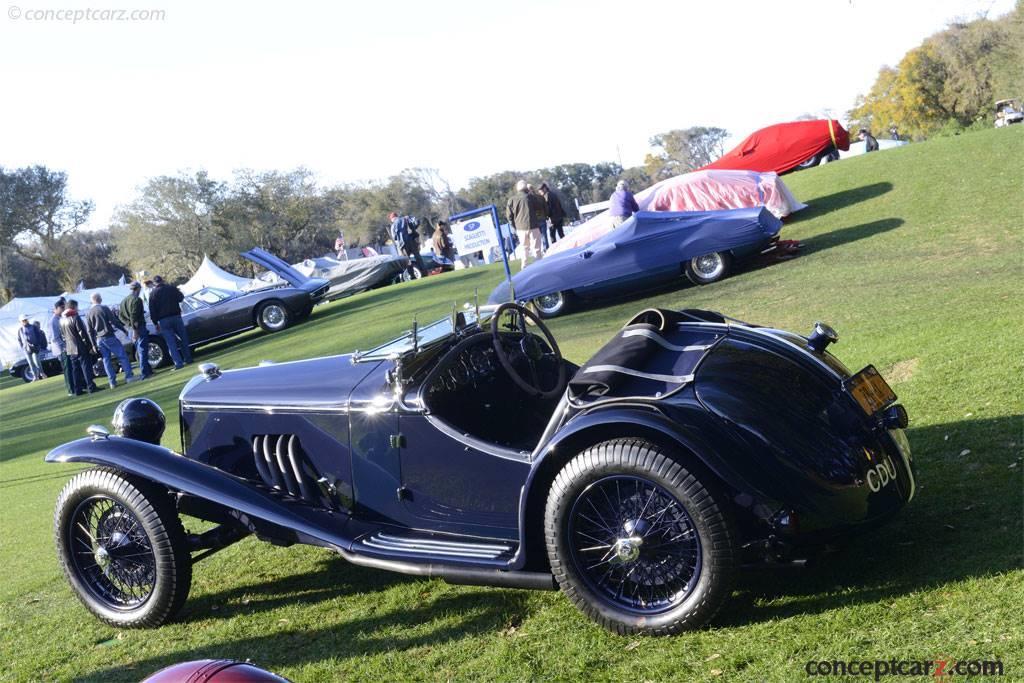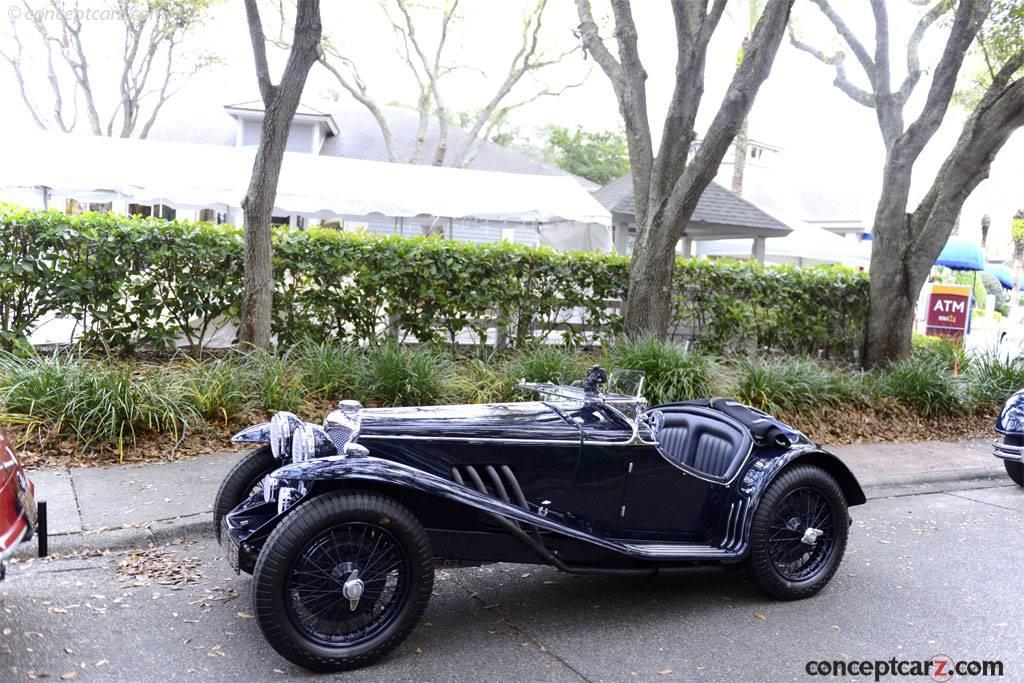The British-based Riley Company was a bicycle and automobile manufacturer from 1909. In 1938, they became part of the Nuffield Organization and in 1968 they merged into the British Leyland Motor Company. Riley production cased in July of 1969 and currently, the Riley trademark is owned by BMW. 
TT Works Team Car
Chassis #: S27S 6031
Engine #: SS 6031
View info and history
Auction entries : 1Percy Riley's 9hp, 1087cc twin-camshaft four was introduced in 1926 and various versions would be used to power Rileys until 1957. The stylish bodywork was provided by Stanley Riley in several different configurations. During the 1930s, the Riley company enjoyed considerable racing success from the small-displacement cars, including the Riley Nine and the Imp. The Nine was powered by an engine with an overhead-valve cylinder head with hemispherical combustion chambers. On either side of the block, above the crankshaft centerline, were valves actuated by separate intake and exhaust camshafts. The valves were positioned at a 90-degree angle and were operated through short vertical pushrods and shaft-mounted rocker arms. The lightweight valve train and direct valve operation gave Riley an advantage over its competition, and by the early 1930s, the Nine had achieved around 20 International Class G Records at distances from 50 kilometers to 3,000 miles, times from one hour to two days and at speeds from 64.37 mph to 108.9 mph. Many of these records were set by Captain G. E. T. Eyston.The Riley Imp was powered by a dual carburetor engine and backed by the company's 'Silent Third' manual transmission, although many were fitted with optional Wilson pre-selector gearboxes. With Riley-built steering and cable-operated brakes, the earliest Imp victory was achieved at the Scottish Rally where it won Class I and Miss Dorothy Champney secured the Ladies' Prize. At the 1934 24 Hours of Le Mans race, six Riley automobiles were entered and all six completed the race. Three Imps finished sixth, twelfth, and thirteenth. At the 1934 Ulster Tourist Trophy, the all-IMP factory contingent finished 9th, 11th, 12th, and 16th-place.
TT Works Team Car
Chassis #: S27S 6031
Engine #: SS 6031
View info and history
Auction entries : 1During the Riley Imp's production, approximately 75 examples were built. Many of the Riley models were named after famous races like the Brooklands and the TT (for the Tourist Trophy). Riley used the 1934 Olympia Motor Show to announce its 1935 model line, which included the company's first new four-cylinder engine in seven years, the 1.5-liter 12/4. The proven twin-camshaft layout was retained for the new Hugh Rose-designed 1.5-liter four-cylinder model. It had a longer wheelbase and a new body style called the Falcon Saloon. Other body styles included the familiar Kestrel saloon and Lynx tourer coachwork. The Riley Sprite was produced from 1935 to 1938 and was an open two-seater sports car that was mostly constructed with a four-cylinder engine, although a 6-cylinder version was available. The chassis was based on the preceding 'MPH' model. The Sprite continued to expand the company's resume with success in many different events, especially in the form of the Riley T.T. Sprite model which eventually earned it the 'Sprite' designation. Again, the 12/4 Sprite was offered with either a pre-selector or short-shift manual gearbox. Body styles included the two-seater sports and three saloons including the Adelphi, a shorter-wheelbase (106-inches) all-steel Merlin, and the six-light Kestrel on the 112.5-inch long-wheelbase chassis. In Standard trim, the 1½-litre 12/4 engine produced 45/46bhp with a single Zenith carburetor. The Special Series came with twin SUs and 52bhp while at the top of the range was the 59/61bhp Sprite specification engine that added £48 to the car's purchase price.
TT Works Team Car
Chassis #: S27S 6031
Engine #: SS 6031
View info and history
Auction entries : 1The 'TT' Sprite won the Ulster Tourist Trophy in both 1935 and 1936 with Freddie Dixon behind the wheel. Numerous privateers were successful at Brooklands and other venues.
by Daniel Vaughan | Mar 2020

TT Works Team Car
Chassis #: S27S 6031
Engine #: SS 6031
View info and history
Auction entries : 1

TT Works Team Car
Chassis #: S27S 6031
Engine #: SS 6031
View info and history
Auction entries : 1

TT Works Team Car
Chassis #: S27S 6031
Engine #: SS 6031
View info and history
Auction entries : 1
by Daniel Vaughan | Mar 2020
Related Reading : Riley Sprite 12/4 History
The Riley Sprite was produced from 1935 to 1938 and its chassis was based on the preceding MPH model. Rileys proven twin-camshaft layout was retained for the new Hugh Rose-designed 1.5-liter four. Body styles included the two-seater sports and three saloons with wheelbases that ranged from 106- to 112.5-inches. The longest wheelbase version was the six-light Kestrel while the shortest was the all-steel....
Continue Reading >>
Continue Reading >>
1937 Riley 12/4 Sprite Vehicle Profiles
Recent Vehicle Additions
Performance and Specification Comparison
Sprite 12/4 Specification Comparison by Year
Year
Production
Wheelbase
Engine
Prices
Related Automotive News
1958 Targa Florio: Musso Commands the Heights
During the invasion of Sicily during the Second World War it would be the mountainous roads around the island that would pose the greatest hindrance to the advance of the British and American forces trying to breakthrough on their way, ultimately, to...

LE MANS WINNER JOCHEN MASS NAMED 2014 AMELIA ISLAND CONCOURS HONOREE
There are scores of victories on Jochen Mass hefty racing resume, but the one that stands out in bold print is the win in France on a June weekend a quarter century ago.
Mass shared one of the mighty Mercedes-Benz powered Sauber C9 Silver Arrows in...

EUROPEAN LE MANS SERIES AND LE MANS 24 HOURS 2013 NELSON PANCIATICI WILL RACE IN ALPINE N° 36
Paris, Friday 22 March Alpine announced today that they are car number 36 in the Le Mans 24 Hours, with Nelson Panciatici, Pierre Ragues and the third driver, freshly appointed, Tristan Gommendy behind the wheel.
Nelson Panciatici, the youngest of...

1955 Tourist Trophy: One Last Victory
The tragedy at Le Mans on the 11th of June, 1955 would dramatically affect motor racing. For one of the manufacturers involved, Mercedes-Benz, it would be a confirmation of what it had already come to believe. Toward the end of the 1955 season it was...

TIMES ARE SET, GRIDS ARE FORMED
Even though the Rolex Monterey Motorsports Reunion is feverishly busy celebrating Shelby Cobras 50th Anniversary, it is simultaneously revealing the rich heritage of historic automobile racing as a whole with 17 different period-specific race groups...














